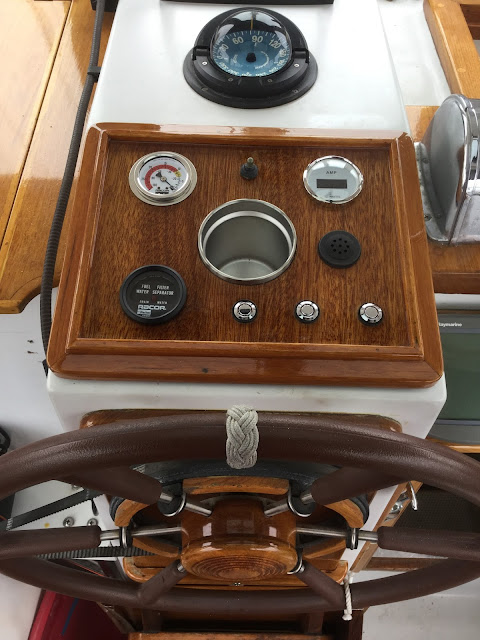First Signs of Winter
So in the mean time, we drive down to the boat, work onboard and drive back to the house at the end of the day. We have had one very cold spell so far, with windchills in the single digits (5 F, -15C) and we stayed home for that; otherwise, even when the nights are in the 20s (-1 to -5C), we still drive down to Rosalind. The cabin heater is making work onboard much more pleasant, even if it takes a little time to warm up the cabin from sub-freezing temperatures.
Since Rosalind went on the hard we have built (out of inexpensive plywood) two wooden boxes to house electrical switches - the boxes will be made out of teak at home this winter when it is too cold to work onboard. One will house switches at the helm and the other will cover the wiring coming down from the mast. Additionally we have installed the new battery charger with its remote control panel and we are very pleased with it. The charger replaced the one that "fell off" the bulkhead earlier in the season.
We are adding a new deck wash pump to help clean the anchor chain when we anchor in mud. On our previous boat we had an anchor locker and no windlass. I could haul the chain up by hand, deposit it in the anchor locker and clean it with buckets of sea water at my convenience. Rosalind has a chain locker below, forward of the V-berth, but no anchor locker. When we want to get going after being at anchor, the windlass hauls the chain and deposits it inside the boat in the chain locker. Because of this, the anchor chain needs to be washed as it comes up. On our shakedown to Saint Michaels it took over twenty buckets of water to clean up all that thick mud. After that, installing the deck wash moved up near the top of the to-do list! The new deck wash pump is installed in the V-berth, and is electrically connected. The plumbing will be connected next. I am replumbing the head (toilet) intake so that the same through-hull seacock and strainer can be used to provide sea water to flush the head or the deck wash by simply turning a valve handle. The valve and pump switch are installed at the base of the V-berth on the port side. This is a very nice location as they can be reached even with the V-berth filler in place. Here are a few pictures of our work. We hope you enjoy them.
Thanks for following us,
Alex and Cheryl

Windshield Wiper Switches - plywood mock-up box being test-fitted at the helm
Newly Installed Battery Charger Control Panel (lower left)
Battery Charger Remote Display -
Conditioning voltage may appear high but it is not. Batteries were at 30F (-1C)!
Deck wash Pump - Sea Water Selector Valve (for Head or Pump) and Pump Electrical Panel
























